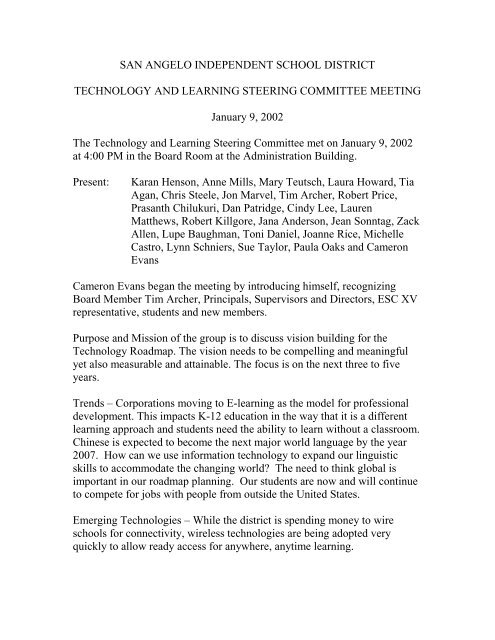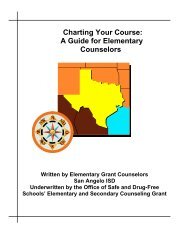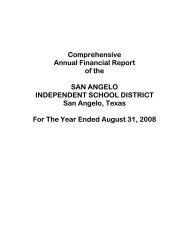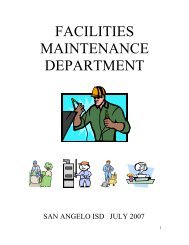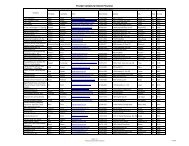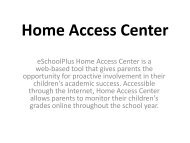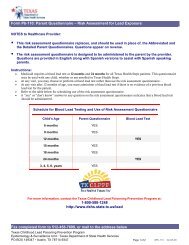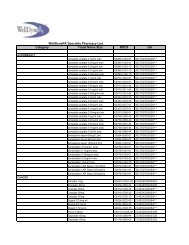SAN ANGELO INDEPENDENT SCHOOL ... - San Angelo ISD
SAN ANGELO INDEPENDENT SCHOOL ... - San Angelo ISD
SAN ANGELO INDEPENDENT SCHOOL ... - San Angelo ISD
Create successful ePaper yourself
Turn your PDF publications into a flip-book with our unique Google optimized e-Paper software.
<strong>SAN</strong> <strong>ANGELO</strong> <strong>INDEPENDENT</strong> <strong>SCHOOL</strong> DISTRICT<br />
TECHNOLOGY AND LEARNING STEERING COMMITTEE MEETING<br />
January 9, 2002<br />
The Technology and Learning Steering Committee met on January 9, 2002<br />
at 4:00 PM in the Board Room at the Administration Building.<br />
Present:<br />
Karan Henson, Anne Mills, Mary Teutsch, Laura Howard, Tia<br />
Agan, Chris Steele, Jon Marvel, Tim Archer, Robert Price,<br />
Prasanth Chilukuri, Dan Patridge, Cindy Lee, Lauren<br />
Matthews, Robert Killgore, Jana Anderson, Jean Sonntag, Zack<br />
Allen, Lupe Baughman, Toni Daniel, Joanne Rice, Michelle<br />
Castro, Lynn Schniers, Sue Taylor, Paula Oaks and Cameron<br />
Evans<br />
Cameron Evans began the meeting by introducing himself, recognizing<br />
Board Member Tim Archer, Principals, Supervisors and Directors, ESC XV<br />
representative, students and new members.<br />
Purpose and Mission of the group is to discuss vision building for the<br />
Technology Roadmap. The vision needs to be compelling and meaningful<br />
yet also measurable and attainable. The focus is on the next three to five<br />
years.<br />
Trends – Corporations moving to E-learning as the model for professional<br />
development. This impacts K-12 education in the way that it is a different<br />
learning approach and students need the ability to learn without a classroom.<br />
Chinese is expected to become the next major world language by the year<br />
2007. How can we use information technology to expand our linguistic<br />
skills to accommodate the changing world? The need to think global is<br />
important in our roadmap planning. Our students are now and will continue<br />
to compete for jobs with people from outside the United States.<br />
Emerging Technologies – While the district is spending money to wire<br />
schools for connectivity, wireless technologies are being adopted very<br />
quickly to allow ready access for anywhere, anytime learning.
Computing devices are also getting smaller and more portable. There is<br />
continuing convergence of voice communications and personal computing.<br />
These new device form factors allow schools to move away from fixed<br />
computing systems, desks and limited floor space.<br />
Other entertainment devices such as televisions, play stations, Xbox, digital<br />
satellite, cable, multimedia projectors and incorporating computer<br />
technology to create smart devices. As a result, the very definition of<br />
computing has changed. Also, now more devices than ever before provide<br />
access to the Internet. This will support closing the Digital Divide and<br />
allowing schools new alternatives for accessing the web.<br />
Mr. Evans also posed several questions to the committee to begin the vision<br />
process:<br />
• What can we do in all of the curricular areas to enhance learning?<br />
• How can we prepare students for life outside of K-12 education?<br />
• Describe what learning looks like in the classroom with robust<br />
technology<br />
Several areas of concern regarding the current state of technology in <strong>San</strong><br />
<strong>Angelo</strong> <strong>ISD</strong> were also discussed. These included the lack of technology in<br />
schools, wiring of campuses, electricity, physical facilities, access to<br />
equipment, internet access and Staff Development.<br />
Cindy Lee – Talked about connectivity in the elementary campuses. She<br />
stressed that her campus needed to be on-line.<br />
Jon Marvel – Stated his feeling is in the last 3-5 years we have been getting<br />
to a certain level. Somewhere in the statement, we need to put in 1-2 years,<br />
we are going to get everything fixed we said we were going to do in the last<br />
3 years that never got done.<br />
Sue Taylor – Introduced the need for continuous staff development for<br />
teachers and principals. Her concern was how she would be able to help<br />
anyone on her campus without staff development?<br />
Joanne Rice – The #1 thing is electricity. (electrical needs). Is there going<br />
to be physical room when you get there? She continued that her visions is, 3
years from now, she wants every teacher to have a computer, internet access<br />
and networked with some form of presenting it to the classroom.<br />
The group defined a computing device as being network ready with internet<br />
access and rich multimedia.<br />
Cameron Evans - Curriculum and Learning with technology needed to have<br />
continuity throughout all grade levels with an emphasis on early preparation<br />
in elementary grades based on the current TEKS requirements.<br />
Sue Taylor – Her vision is have the ability – have the teachers prepared so<br />
that in elementary we can do this so that secondary can “move on down the<br />
road.”<br />
Karen Henson – Introduce the need for who would be responsible for buying<br />
the technology for these students.<br />
Lynn Schniers – Would like the principals to be told in advance what they<br />
need to take out of the budget and how they need to arrange the budget for<br />
technology.<br />
Cameron Evans suggested not arranging for technology but for learning.<br />
Cameron Evans – Would it be wise or even safe to say that in order for us to<br />
be successful with technology in <strong>San</strong> <strong>Angelo</strong> Independent School District, is<br />
that our culture as a learning institution has to dramatically change from the<br />
way we do business today in order to embrace using technology effectively<br />
in this school district.<br />
Joanne Rice – That should be the vision statement.<br />
Robert Price – The first word to put on the board is access. You need to get<br />
the teachers access so they can teach and we need more people in IT support.<br />
Karen Henson – Her vision is that all kids are reached. They don’t have it at<br />
home, they don’t have it in elementary and they don’t even have the<br />
opportunity.
Lauren Matthews – You need to have teachers who want to teach a class<br />
digitally. You need to make technology attractive and convenient so they<br />
will want to use it.<br />
Group discussion – Technology implementation strategies have not been<br />
written into the curriculum. Moreover, the curriculum needed to be updated<br />
to include the core discipline. English, Math, Science and Social Studies to<br />
reinforce critical think, problem solving and skills assessment.<br />
Students of the 21 st century are growing up with technology. In order to be<br />
successful in the integration of technology into the classroom, the District<br />
must change the way it views the importance of technology in education.<br />
The next scheduled meeting for the Technology Steering Committee will be<br />
Wednesday, January 23, 2002 at 4:00 PM.


